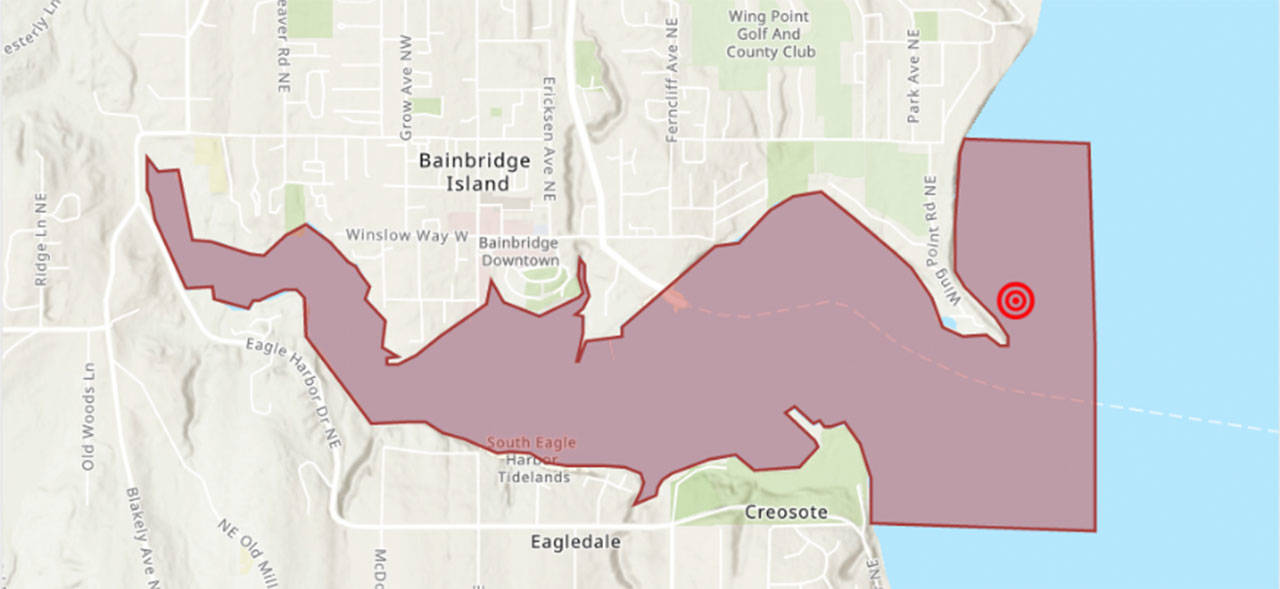Heavy rains caused the Winslow Wastewater Treatment Plan to overflow, allowing about 250,000 gallons of partially treated sewage into Eagle Harbor.
That led to the Kitsap Public Health District issuing a no-contact advisory for Eagle Harbor — the second in a week — until Jan. 8.
From about 9:30 p.m. Jan. 2 to 12:30 a.m. Jan. 3 approximately 250,000 gallons of partially treated effluent was discharged from the wastewater plant outfall into Puget Sound, east of Wing Point. The discharge occurred due to heavy rainfall that exceeded the plant’s capability to fully treat the wastewater. City staff stopped the discharge by reconfiguring the plant to increase capacity. An on-call staff technician became aware of the incident through an alarm on the system.
Public Works director Chris Wierzbicki said that was the largest such event he’s seen in his 18 months with the city. He said they are still determining the best course of action for handling that type of flow after heavy rains in the future.
“We are still in the process of sorting through the decision-making process behind what happened,” he says in an email to the Review.
He said there are options for dealing with such overflows, such as bringing additional facilities online, but those also carry risks.
Wierzbicki said the discharge was not raw sewage, but partially treated wastewater. As a result, the discharge contained suspended solids that exceeded their permit requirements.
He added that the discharge will likely dissipate in the tides.
The health district also issued a no-contact advisory for Eagle Harbor Dec. 28 due to a blocked sewer main, which caused a manhole at Winslow Way East and Eagle Place to overflow. That caused an estimated 5,300 gallons of sewage to flow to Eagle Harbor.
The latest advisory extends farther into Puget Sound than last week’s.
City crews performed a video inspection of the sewer main but were not able to determine a cause of the sewer blockage. Typically, such blockages are caused by disposable wipes, rags and grease being dumped into the sewer. The advisory for that incident expired Jan. 1.
Wierzbicki said the only way the city finds out about such events is when it’s reported by someone near the site.
“We have a handful of such events every year,” he added.
The public is advised to avoid contact with water in the harbor. The health district recommends against swimming, wading or types of water recreation that could cause water to be swallowed or get into the mouth, nose or eyes. People should immediately wash with soap and clean water if they have exposure to the water. No shellfishing is allowed either.
Warning signs were to be posted at public access points to Eagle Harbor.
The city has staff on call 24 hours per day, and the public is always advised to call 9-1-1 to report emergencies, such as sewage spills, after normal working hours and on weekends.
Other spills
Sewage spills are not that uncommon on BI. Such a spill from King County affected local shorelines in July of 2019. Also that year in February, BI had its own spill on its southern shoreline.
Another one from King County led to a shellfish ban on BI’s eastern shores in February of 2017.
It was a bad year for BI sewage spills in 2014 with four – all in Eagle Harbor. They happened in October, June, February and January.
About the plant
The Winslow wastewater collection system flows to the Winslow Wastewater Treatment Plant owned and operated by the city. The sludge plant uses dissolved oxygen for solids treatment and ultraviolet light for disinfection.
Each year the plant treats 150 million gallons of wastewater with typical conventional pollutant removals above 97 percent. The treated wastewater is discharged east of Wing Point into Puget Sound.


